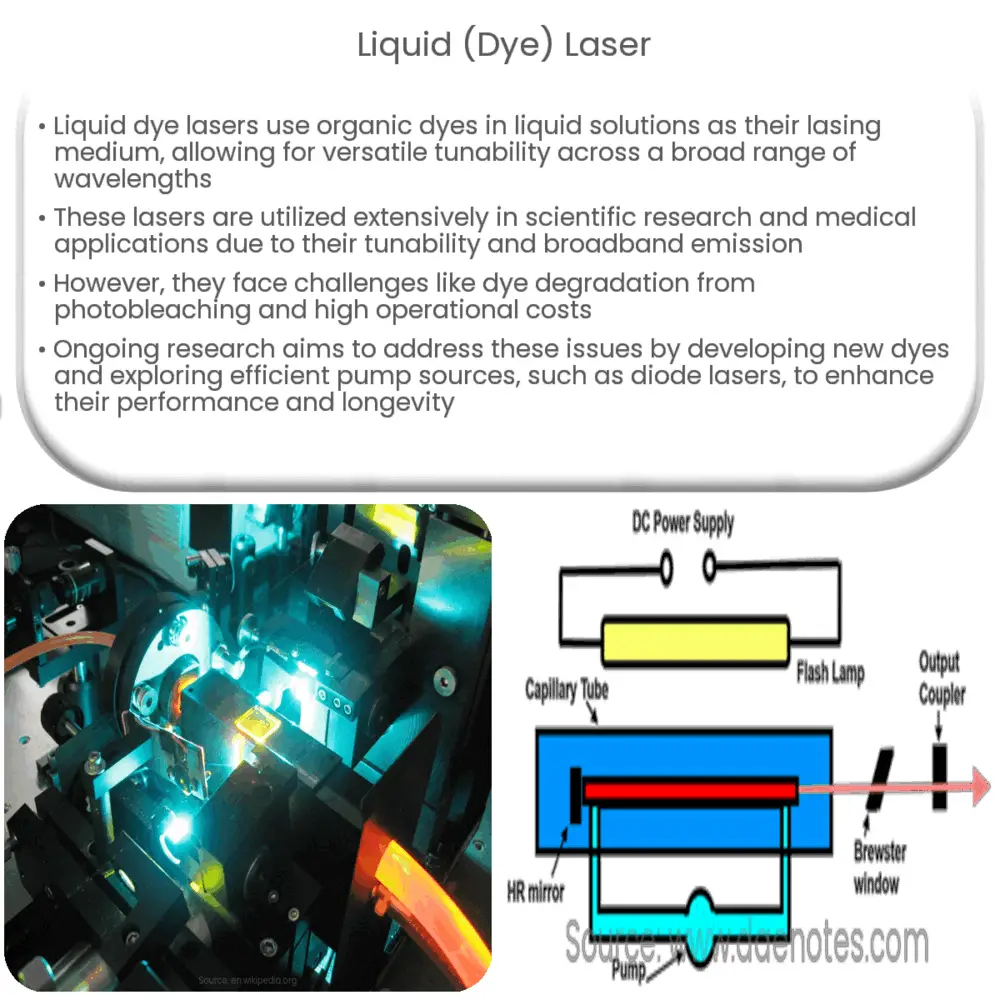Explore the world of liquid dye lasers, their operation, applications, challenges, and future prospects in this comprehensive article.

Liquid (Dye) Lasers: An Overview
Dye lasers are a unique type of laser technology that use organic dyes, dissolved in liquid solutions, as the lasing medium. They exhibit versatile tunability and are capable of emitting light over a broad range of wavelengths, making them particularly useful in various scientific and industrial applications.
Principle of Operation
The operation of a liquid dye laser begins with the preparation of the dye solution. This solution is typically composed of a complex organic molecule that can fluoresce, i.e., absorb light at one wavelength and then re-emit it at a longer wavelength. The dye molecules are dissolved in a solvent to create the liquid laser medium.
When the dye solution is illuminated with a powerful light source, such as a flashlamp or another laser, the dye molecules absorb the energy and reach an excited state. This excited state is unstable, and the molecules quickly return to their ground state, releasing their excess energy in the form of photons. This process is known as stimulated emission, and it is the fundamental mechanism by which all lasers operate.
- Tunable Output: The most significant advantage of dye lasers is their tunability. The output wavelength can be varied over a broad range by simply changing the dye or adjusting the concentration of the dye in the solution.
- Broadband Emission: Dye lasers are also known for their broadband emission. This means they can emit light over a wide range of wavelengths, which is particularly useful for applications like spectroscopy where a broad spectrum of light is required.
Applications of Liquid Dye Lasers
Liquid dye lasers have found wide-ranging applications in various fields, primarily due to their tunability and broadband emission characteristics. Here are some of the key applications:
- Scientific Research: Dye lasers are commonly used in scientific research, particularly in areas like spectroscopy and photochemistry. They are also used in studies involving quantum mechanics and atomic physics.
- Medicine: In the medical field, dye lasers are used for procedures like laser eye surgery and dermatological treatments. Their ability to be precisely tuned to specific wavelengths allows for targeted treatment, minimizing damage to surrounding tissues.
While these benefits make dye lasers incredibly versatile, they also present certain challenges. The subsequent part of this article will delve into the limitations of liquid dye lasers, potential solutions, and the future direction of this technology.
Challenges and Limitations
Despite the advantages of liquid dye lasers, they do come with their own set of challenges. The organic dyes used in these lasers tend to degrade over time due to photobleaching, which affects the longevity and efficiency of the laser. Additionally, the operation of these lasers often requires a high power pump source, leading to increased operational costs.
Potential Solutions
Addressing the limitations of dye lasers is a key area of ongoing research. Efforts are being made to develop new dyes and solvent systems that can resist photobleaching and improve the longevity of the laser. Moreover, the use of diode lasers as pump sources is being explored to reduce the operational cost and increase the overall efficiency of the system.
- Development of New Dyes: Scientists are continually developing new dyes that can resist photobleaching and extend the operational lifetime of the laser.
- Use of Diode Lasers: Diode lasers are being considered as pump sources to reduce operational costs and improve the overall efficiency of the system.
The Future of Liquid Dye Lasers
The future of liquid dye lasers appears promising. The ongoing advancements in the field aim to overcome the present limitations and expand their use in various applications. The continued development of new dyes, improvements in pump sources, and innovative system designs are likely to further enhance the performance and versatility of these lasers.
Conclusion
In conclusion, liquid dye lasers, with their unique characteristics of tunability and broadband emission, have found significant applications in diverse fields ranging from scientific research to medicine. While they do pose certain challenges, the ongoing research and developments in this field are promising and are likely to address these limitations. As we continue to innovate and improve upon this technology, we can expect to see liquid dye lasers playing an even more vital role in various scientific and technological applications in the future.

